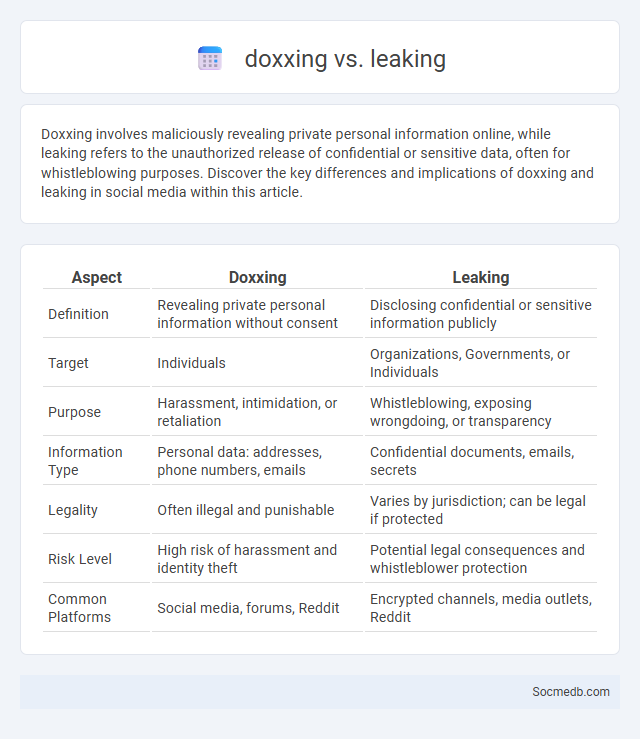
Photo illustration: doxxing vs leaking
Doxxing involves maliciously revealing private personal information online, while leaking refers to the unauthorized release of confidential or sensitive data, often for whistleblowing purposes. Discover the key differences and implications of doxxing and leaking in social media within this article.
Table of Comparison
| Aspect | Doxxing | Leaking |
|---|---|---|
| Definition | Revealing private personal information without consent | Disclosing confidential or sensitive information publicly |
| Target | Individuals | Organizations, Governments, or Individuals |
| Purpose | Harassment, intimidation, or retaliation | Whistleblowing, exposing wrongdoing, or transparency |
| Information Type | Personal data: addresses, phone numbers, emails | Confidential documents, emails, secrets |
| Legality | Often illegal and punishable | Varies by jurisdiction; can be legal if protected |
| Risk Level | High risk of harassment and identity theft | Potential legal consequences and whistleblower protection |
| Common Platforms | Social media, forums, Reddit | Encrypted channels, media outlets, Reddit |
Introduction to Digital Information Exposure
Digital information exposure on social media involves the extensive sharing and consumption of personal and public data across various platforms. Your interactions, preferences, and online behaviors generate vast amounts of digital footprints that companies analyze for targeted advertising and content personalization. Understanding the risks and benefits of this exposure helps you manage privacy settings and protect sensitive information effectively.
Defining Doxxing: Intent and Process
Doxxing involves the intentional collection and public exposure of an individual's private information, such as addresses, phone numbers, or financial details, without their consent. This process typically uses social media platforms to gather data from various online sources, amplifying the risk of harassment or identity theft. By understanding the intent behind doxxing, which includes intimidation or revenge, Your awareness and caution in sharing personal details online become essential for protection.
What Constitutes Leaking: Differences from Doxxing
Leaking involves the unauthorized release of confidential or sensitive information, typically related to organizations or government entities, aiming to expose wrongdoing or unethical practices. In contrast, doxxing specifically targets individuals by publishing private personal data such as home addresses, phone numbers, or social security numbers, often to intimidate or harass. The key difference lies in the scope and intent: leaking serves a whistleblower or activist purpose, whereas doxxing is primarily a form of online harassment or retaliation.
Personal Information Doxxing: Scope and Impact
Personal information doxxing on social media involves the unauthorized sharing of sensitive data such as addresses, phone numbers, or financial details, exposing victims to privacy breaches and identity theft. This practice significantly escalates risks of harassment, stalking, and psychological distress, impacting individuals' safety and mental well-being. Platforms face increasing pressure to implement robust security measures and real-time monitoring to mitigate the spread and impact of doxxing incidents.
Legal Perspectives: Doxxing vs. Leaks
Legal perspectives on social media distinguish doxxing as the intentional public release of private information without consent, often violating privacy laws and exposing individuals to harassment or harm. Leaks, by contrast, typically involve the disclosure of confidential information deemed in the public interest, sometimes protected under whistleblower laws but potentially prosecuted under data protection statutes. Courts evaluate factors such as intent, consent, and potential damage to determine liability and applicable penalties in cases involving online disclosures.
Motivations Behind Doxxing and Leaking
Doxxing and leaking on social media are often driven by motivations such as exposing wrongdoing, seeking justice, or retaliating against perceived personal or professional harm. Users may also engage in these acts to assert power, spread information quickly, or influence public opinion. Understanding these motivations is crucial for developing effective policies to mitigate privacy violations and protect individuals online.
Consequences for Victims: Emotional and Digital Harm
Social media exposure can lead to severe emotional consequences for victims, including anxiety, depression, and diminished self-esteem. Digital harm manifests as cyberbullying, identity theft, and unauthorized sharing of personal information, causing long-term psychological distress. Victims often experience social isolation and difficulty trusting others, resulting in significant impairment of mental health and online safety.
Preventative Measures Against Doxxing and Leaks
Implement robust privacy settings on your social media accounts to limit the exposure of personal information and reduce the risk of doxxing and data leaks. Use strong, unique passwords combined with two-factor authentication to protect your accounts from unauthorized access. Regularly review friend lists and app permissions, and avoid sharing sensitive information that could be exploited by malicious actors.
Case Studies: Real-World Examples
Case studies in social media marketing provide valuable insights into successful strategies by showcasing real-world examples of brand engagement and audience growth. These examples highlight how targeted content and analytical tools drive measurable results such as increased conversion rates and enhanced customer loyalty. Your business can leverage these proven tactics to optimize campaigns and achieve similar success in competitive social platforms.
Conclusion: Navigating Online Privacy and Security
Navigating online privacy and security on social media requires proactive use of privacy settings and strong, unique passwords to protect personal data. Awareness of phishing scams, malware, and data breaches is essential for minimizing digital risks. Regularly updating software and understanding platform-specific privacy policies further enhance user safety in the evolving social media landscape.
 socmedb.com
socmedb.com